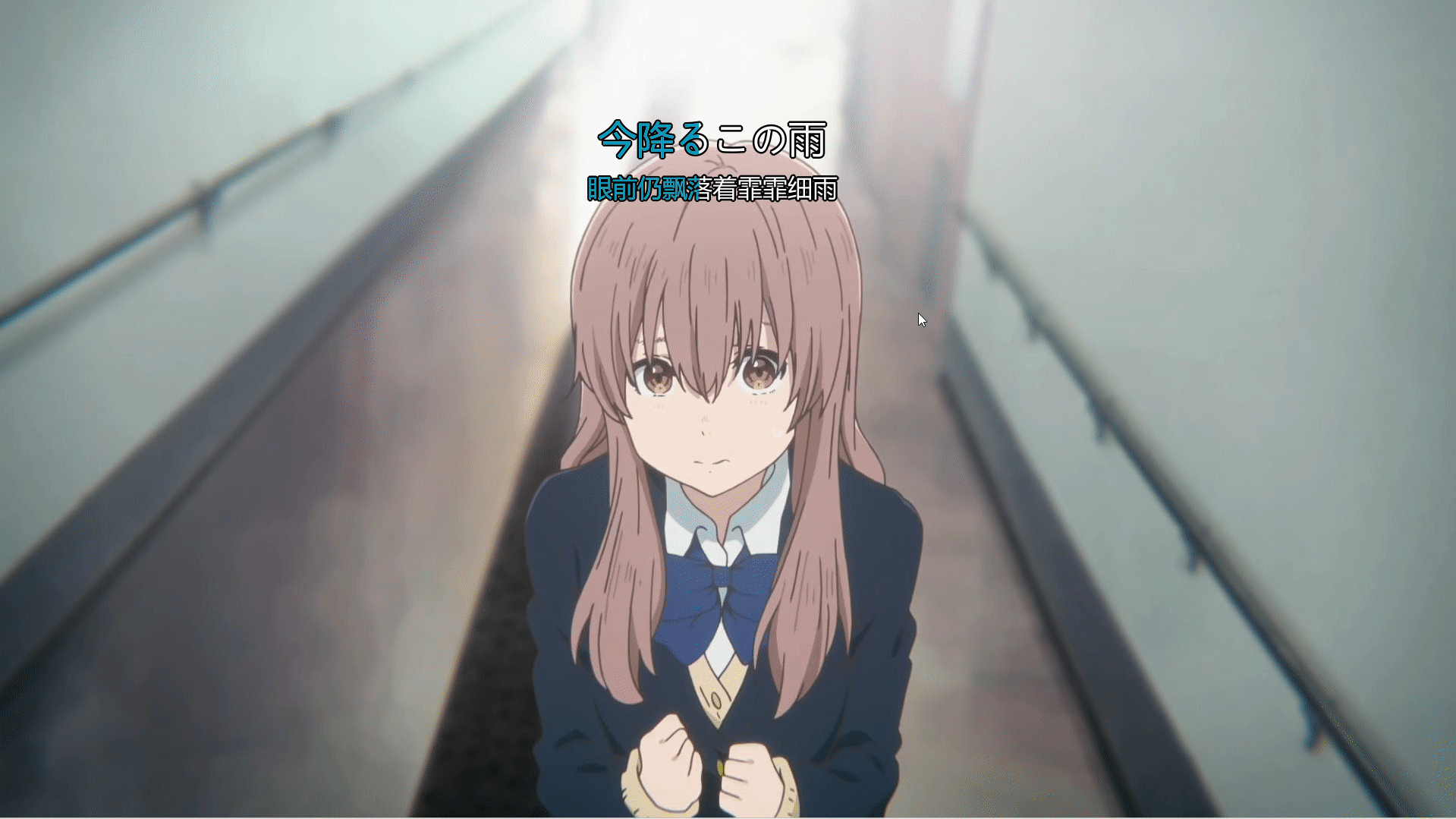

如何在 pyqt 中实现桌面歌词 - 之一Yo
source link: https://www.cnblogs.com/zhiyiYo/p/16513008.html
Go to the source link to view the article. You can view the picture content, updated content and better typesetting reading experience. If the link is broken, please click the button below to view the snapshot at that time.


如何在 pyqt 中实现桌面歌词
酷狗、网抑云和 QQ 音乐都有桌面歌词功能,这篇博客也将使用 pyqt 实现桌面歌词功能,效果如下图所示:
桌面歌词部件 LyricWidget 在 paintEvent 中绘制歌词。我们可以直接使用 QPainter.drawText 来绘制文本,但是通过这种方式无法对歌词进行描边。所以这里更换为 QPainterPath 来实现,使用 QPainterPath.addText 将歌词添加到绘制路径中,接着使用 Qainter.strokePath 进行描边,Qainter.fillPath 绘制歌词,这里的绘制顺序不能调换。
对于歌词的高亮部分需要特殊处理,假设当前高亮部分的宽度为 w,我们需要对先前绘制歌词的 QPainterPath 进行裁剪,只留下宽度为 w 的部分,此处通过 QPainterPath.intersected 计算与宽度为 w 的矩形路径的交集来实现裁剪。
对于高亮部分的动画,我们既可以使用传统的 QTimer,也可以使用封装地更加彻底的 QPropertyAnimation 来实现(本文使用后者)。这里需要进行动画展示的是高亮部分,也就是说我们只需改变“高亮宽度”这个属性即可。PyQt 为我们提供了 pyqtProperty,类似于 python 自带的 property,使用 pyqtProperty 可以给部件注册一个属性,该属性可以搭配动画来食用。
除了高亮动画外,我们还在 LyricWidget 中注册了滚动动画,用于处理歌词长度大于视口宽度的情况。
复制# coding:utf-8
from PyQt5.QtCore import QPointF, QPropertyAnimation, Qt, pyqtProperty
from PyQt5.QtGui import (QColor, QFont, QFontMetrics, QPainter, QPainterPath,
QPen)
from PyQt5.QtWidgets import QWidget
config = {
"lyric.font-color": [255, 255, 255],
"lyric.highlight-color": [0, 153, 188],
"lyric.font-size": 50,
"lyric.stroke-size": 5,
"lyric.stroke-color": [0, 0, 0],
"lyric.font-family": "Microsoft YaHei",
"lyric.alignment": "Center"
}
class LyricWidget(QWidget):
""" Lyric widget """
def __init__(self, parent=None):
super().__init__(parent=parent)
self.setAttribute(Qt.WA_TranslucentBackground)
self.lyric = []
self.duration = 0
self.__originMaskWidth = 0
self.__translationMaskWidth = 0
self.__originTextX = 0
self.__translationTextX = 0
self.originMaskWidthAni = QPropertyAnimation(
self, b'originMaskWidth', self)
self.translationMaskWidthAni = QPropertyAnimation(
self, b'translationMaskWidth', self)
self.originTextXAni = QPropertyAnimation(
self, b'originTextX', self)
self.translationTextXAni = QPropertyAnimation(
self, b'translationTextX', self)
def paintEvent(self, e):
if not self.lyric:
return
painter = QPainter(self)
painter.setRenderHints(
QPainter.Antialiasing | QPainter.TextAntialiasing)
# draw original lyric
self.__drawLyric(
painter,
self.originTextX,
config["lyric.font-size"],
self.originMaskWidth,
self.originFont,
self.lyric[0]
)
if not self.hasTranslation():
return
# draw translation lyric
self.__drawLyric(
painter,
self.translationTextX,
25 + config["lyric.font-size"]*5/3,
self.translationMaskWidth,
self.translationFont,
self.lyric[1]
)
def __drawLyric(self, painter: QPainter, x, y, width, font: QFont, text: str):
""" draw lyric """
painter.setFont(font)
# draw background text
path = QPainterPath()
path.addText(QPointF(x, y), font, text)
painter.strokePath(path, QPen(
QColor(*config["lyric.stroke-color"]), config["lyric.stroke-size"]))
painter.fillPath(path, QColor(*config['lyric.font-color']))
# draw foreground text
painter.fillPath(
self.__getMaskedLyricPath(path, width),
QColor(*config['lyric.highlight-color'])
)
def __getMaskedLyricPath(self, path: QPainterPath, width: float):
""" get the masked lyric path """
subPath = QPainterPath()
rect = path.boundingRect()
rect.setWidth(width)
subPath.addRect(rect)
return path.intersected(subPath)
def setLyric(self, lyric: list, duration: int, update=False):
""" set lyric
Parameters
----------
lyric: list
list contains original lyric and translation lyric
duration: int
lyric duration in milliseconds
update: bool
update immediately or not
"""
self.lyric = lyric or [""]
self.duration = max(duration, 1)
self.__originMaskWidth = 0
self.__translationMaskWidth = 0
# stop running animations
for ani in self.findChildren(QPropertyAnimation):
if ani.state() == ani.Running:
ani.stop()
# start scroll animation if text is too long
fontMetrics = QFontMetrics(self.originFont)
w = fontMetrics.width(lyric[0])
if w > self.width():
x = self.width() - w
self.__setAnimation(self.originTextXAni, 0, x)
else:
self.__originTextX = self.__getLyricX(w)
self.originTextXAni.setEndValue(None)
# start foreground color animation
self.__setAnimation(self.originMaskWidthAni, 0, w)
if self.hasTranslation():
fontMetrics = QFontMetrics(self.translationFont)
w = fontMetrics.width(lyric[1])
if w > self.width():
x = self.width() - w
self.__setAnimation(self.translationTextXAni, 0, x)
else:
self.__translationTextX = self.__getLyricX(w)
self.translationTextXAni.setEndValue(None)
self.__setAnimation(self.translationMaskWidthAni, 0, w)
if update:
self.update()
def __getLyricX(self, w: float):
""" get the x coordinate of lyric """
alignment = config["lyric.alignment"]
if alignment == "Right":
return self.width() - w
elif alignment == "Left":
return 0
return self.width()/2 - w/2
def getOriginMaskWidth(self):
return self.__originMaskWidth
def getTranslationMaskWidth(self):
return self.__translationMaskWidth
def getOriginTextX(self):
return self.__originTextX
def getTranslationTextX(self):
return self.__translationTextX
def setOriginMaskWidth(self, pos: int):
self.__originMaskWidth = pos
self.update()
def setTranslationMaskWidth(self, pos: int):
self.__translationMaskWidth = pos
self.update()
def setOriginTextX(self, pos: int):
self.__originTextX = pos
self.update()
def setTranslationTextX(self, pos):
self.__translationTextX = pos
self.update()
def __setAnimation(self, ani: QPropertyAnimation, start, end):
if ani.state() == ani.Running:
ani.stop()
ani.setStartValue(start)
ani.setEndValue(end)
ani.setDuration(self.duration)
def setPlay(self, isPlay: bool):
""" set the play status of lyric """
for ani in self.findChildren(QPropertyAnimation):
if isPlay and ani.state() != ani.Running and ani.endValue() is not None:
ani.start()
elif not isPlay and ani.state() == ani.Running:
ani.pause()
def hasTranslation(self):
return len(self.lyric) == 2
def minimumHeight(self) -> int:
size = config["lyric.font-size"]
h = size/1.5+60 if self.hasTranslation() else 40
return int(size+h)
@property
def originFont(self):
font = QFont(config["lyric.font-family"])
font.setPixelSize(config["lyric.font-size"])
return font
@property
def translationFont(self):
font = QFont(config["lyric.font-family"])
font.setPixelSize(config["lyric.font-size"]//1.5)
return font
originMaskWidth = pyqtProperty(
float, getOriginMaskWidth, setOriginMaskWidth)
translationMaskWidth = pyqtProperty(
float, getTranslationMaskWidth, setTranslationMaskWidth)
originTextX = pyqtProperty(float, getOriginTextX, setOriginTextX)
translationTextX = pyqtProperty(
float, getTranslationTextX, setTranslationTextX)
上述代码对外提供了两个接口 setLyric(lyric, duration, update) 和 setPlay(isPlay),用于更新歌词和控制歌词动画的开始与暂停。下面是一个最小使用示例,里面使用 Qt.SubWindow 标志使得桌面歌词可以在主界面最小化后仍然显示在桌面上,同时不会多出一个应用图标(Windows 是这样,Linux 不一定):
复制class Demo(QWidget):
def __init__(self):
super().__init__(parent=None)
# 创建桌面歌词
self.desktopLyric = QWidget()
self.lyricWidget = LyricWidget(self.desktopLyric)
self.desktopLyric.setAttribute(Qt.WA_TranslucentBackground)
self.desktopLyric.setWindowFlags(
Qt.FramelessWindowHint | Qt.SubWindow | Qt.WindowStaysOnTopHint)
self.desktopLyric.resize(800, 300)
self.lyricWidget.resize(800, 300)
# 必须有这一行才能显示桌面歌词界面
self.desktopLyric.show()
# 设置歌词
self.lyricWidget.setLyric(["Test desktop lyric style", "测试桌面歌词样式"], 3000)
self.lyricWidget.setPlay(True)
if __name__ == '__main__':
app = QApplication(sys.argv)
w = Demo()
w.show()
app.exec_()
至此关于桌面歌词的实现方案已经介绍完毕,完整的播放器界面代码可参见:https://github.com/zhiyiYo/Groove,以上~~
Recommend
About Joyk
Aggregate valuable and interesting links.
Joyk means Joy of geeK
